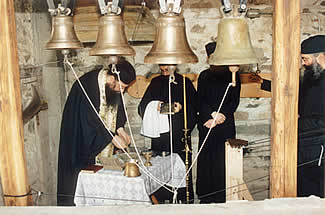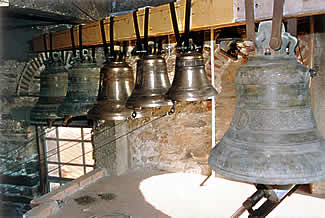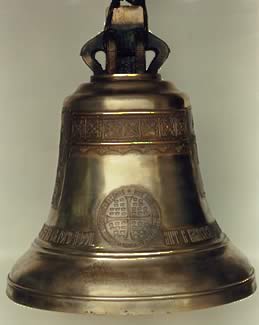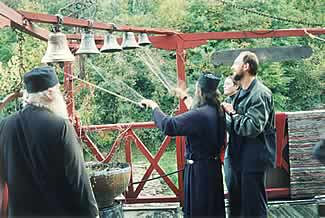 |
|
Gerontas Iosif of Xeropotamou Monastery, Mount Athos, and members of the brotherhood bless the new Pyatkov bells in their refurbished bell tower. |
New Russian bells on Mount Athos
In October 2002, Victor Sharikov, Alexander Belyakov, and Alexei Greshilo, specialists from the Moscow Bell Center, visited the Holy Mountain to set up a new zvonnitsa at Xeropotamou Monastery.
This monastery is located not far from the Russian monastery of St Panteleimon, whose bells are considered the best on Mount Athos. Therefore, in 1999, when Xeropotamou decided to restore their zvonnitsa, they chose to set up their bells in the Russian manner.
The abbot of the monastery, Fr. Iosif, asked the Moscow Bell Center to help with this project. The Bell Center for its part offered the monastery a turnkey solution which included selection and acquisition of the bells, their transportation, mounting in the proper configuration, construction of the bell-ringer's podium, and training the monks in the Russian style of ringing.
 |
|
Xeropotamou now has a set of nine bells, including new and old. The Moscow Bell Center matched the monastery's older bells with six new ones. |
Examination of the existing Athonite bell tower showed that to establish a classical setup in which the blagovest or bass bell would be rung by pedal, the podzvonny or alto bells from a podium, and the zazvonny or soprano bells by hand, it would be necessary to reconstruct the ringing floor of the tower. It was necessary to reposition beams in order to make room for the podium, to remount the existing bells, and to move the tower clock.
The bell tower had eight existing bells— three from Greece and five 19th century Russian bells, two of which, weighing 10 and 2 puds (160 and 32 kg) respectively, were cast by the Olovannishnikov Bell Foundry of Yaroslavl'; one of 8 puds (128 kg), cast by the Samgin Foundry of Moscow; another of 54 puds (864 kg) by Vasilenko of Rostov on the Don; and the other undetermined. (The pud is a standard mediaeval measure of weight still used in Russian bell-making, equivalent to about 16 kg or 36 lbs.)
 |
|
The larger bells feature inscriptions, icons, and the seal of the monastery. |
After testing the condition of these old bells and the quality of their sound, the Bell Center recommended that the new zvonnitsa be configured with ten bells: four of the old bells, including the 54 pud blagovestnik, the 10 and 8 pud podzvonny bells, and one small Greek zazvonny bell, plus six new bells of 6, 10, 15, 24, 41, and 99 kg, to be made at the Pyatkov & Co. foundry in Kamensk-Uralskij.
All the new bells are ornamented with a band of quatrefoils around the shoulder. The 41 kg bell also features an icon of St Paul the Founder of Xeropotamou and the seal of the monastery, and the 99 kg bell bears icons of the Resurrection of Christ and of the Holy Cross and the seal of the monastery.
The new bells were delivered to the monastery in the autumn of 2002 and Abbot Iosif consecrated them in a service which brought together not only the brethren of the monastery but many monks from many other Athonite monasteries as well, who came to hear the Russian zvons.
After the blessing of the bells, the Moscow ringers played a festal zvon.
The Bell Center's master ringers received an invitation to visit Athos in 2003, as another monastery has expressed interest in a similar turnkey project. One of them, Alexei Greshilo, an experienced art restorer, was also invited to Xeropotamou to work on one of the rebuilt chapels of the monastery.
 |
|
Part of the Moscow Bell Center's work was teaching the monks how to play their new bells. |
[After Maria Eltsova, Tserkovny Vestnik No. 23 (252), Dec 2002]